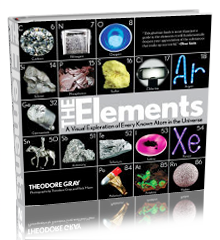Cast lead cylinder 2() | |||
| Sample Image | QuickTimeVR Rotation | |||
| Cast lead cylinder 2. (External Sample) See above for more about these cylinders. This one shows what happens if you dip the cast cylinder in 30% HCl ("Muriatic acid") before varnishing it. The facets show where the boundaries of different crystal zones are. As the cylinder cooled in the mold, crystals started growing from multiple points in the liquid: They grew out until they met another crystal coming from a different direction. The result is a patchwork of internal zones, which are visible on the surface as patches that reflect light differently. Why do they reflect differently? The acid removes the surface oxidation and then starts attacking the lead itself. The lead is more vulnerable along one of its crystal axes than the others, and ridges are formed aligned with the orientation of the crystal. These ridges act as a diffraction grating that causes light from a particular direction to be reflected more strongly than light from other directions. Since the crystals zones are oriented in different directions, the patches show brighter or darker depending on which ones happen to be properly aligned with the light. Look at the QuickTime VR rotatable image to see how this play of light works. (Click the turntable icon in the top right corner of this text.) If you compare this cylinder with the one below, you'll see that this one has much larger crystal zones than the other one. The size of the zones depends on the rate of cooling: If the material cools slowly, each crystal has longer to grow before another zone starts up and runs into it. If the cylinder cools quickly, many crystals start forming at once and each individual one doesn't have as much room to grow. If cooling is very fast, you may not get any visible crystals at all. To make this cylinder I heated the graphite mold by floating it on the pool of molten lead for several minutes before pouring the lead in. The lead then stayed liquid for a while and cooled slowly as the whole mold cooled down. The cylinder below was made the same way, but with the mold heated less. Location: Oliver Sacks' Office Photographed: 10 February, 2004 Size: 2 Purity: >99% | |||
|

